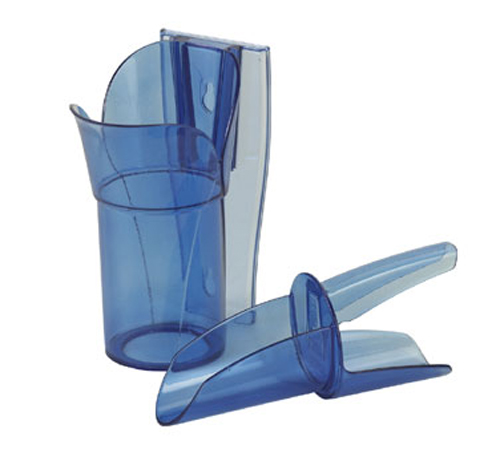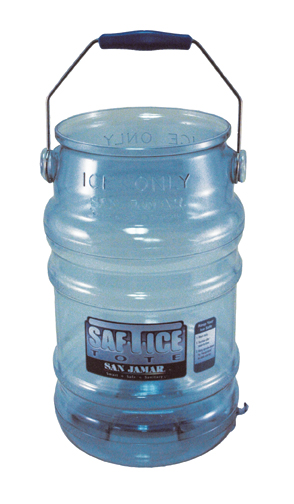Getting ice from the ice machine bin to your customer’s drink glass without contaminating it is a food safety consideration that is easy to overlook. That doesn’t mean it’s any less important than the other danger points you deal with every day while preparing and serving food in your restaurant. In fact, proper ice handling is probably even more important because you don’t have the insurance that heating something about to be eaten by a customer brings you.
The key to keeping your ice safe for consumption is to limit the points of contact it has in its journey from bin to glass. Having the proper tools is essential to limiting contact, and in recent years reputable companies like San Jamar have developed products that make the transportation of ice a much more sanitary exercise than just scooping and dumping in a bucket.
 Proper ice handling starts with the scoop. A good ice scoop should have two key components that prevent the user from unintentionally contaminating the ice: a knuckle guard and a holder. The knuckle guard prevents hands (and the pathogens that might be living there) from coming into direct contact with the ice, either in the bin or in an ice bucket. The scoop holder provides a sanitary place to leave the ice scoop when it’s not in use. A good scoop holder completely encompasses the scoop so that outside contaminants can’t come into contact with the scoop.
Proper ice handling starts with the scoop. A good ice scoop should have two key components that prevent the user from unintentionally contaminating the ice: a knuckle guard and a holder. The knuckle guard prevents hands (and the pathogens that might be living there) from coming into direct contact with the ice, either in the bin or in an ice bucket. The scoop holder provides a sanitary place to leave the ice scoop when it’s not in use. A good scoop holder completely encompasses the scoop so that outside contaminants can’t come into contact with the scoop.
Part of your food safety SOP’s should be to clean and sanitize the ice scoop and holder on a regular schedule, preferably once a day. That way you ensure that the scoop remains sanitary and doesn’t communicate bugs to your customer’s ice.
The next place ice contamination likes to occur is the ice tote or ice bucket. For years the ice bucket has been nothing more than a 5 gallon plastic bucket that gets filled with ice for transport to the bar, a server station, or the kitchen. The problem with a simple bucket is that the open top and lack of a handle on the side don’t inhibit possible contamination. Stuff can fall into a 5 gallon bucket. And when someone is dumping ice, it’s easy to allow dirty hands to come into contact with the ice.
Newer ice totes have a lid and a side or bottom handle to limit possible contact with contaminants. That makes it easy to transport ice without worrying about contamination, no matter who’s doing the work.
Finally, proper handwashing should be standard operating procedure for whoever is moving ice. While newer tools for moving ice are designed to minimize contact, that doesn’t lessen the importance of clean hands for whoever is handling the ice. Some proper training and enforcement is needed to ensure employees are handling ice with the goal of minimizing contamination.
 Corner Booth Blog | TundraFMP Restaurant Supply, News & Equipment Blog
Corner Booth Blog | TundraFMP Restaurant Supply, News & Equipment Blog




I think everyone who works in food service should read this article. It seems that ice isn’t always considered a food and is overlooked when it comes to food safety. Have you ever seen a bartender take the glass you’ve already used and use it to get ice for your next drink instead of using a scoop? The other key to handling ice safely is employee training. Ice is the one food that potentially any employee can come in contact with from hostesses to cooks.
Gross. I never thought of the bartender stiuation but it happens all the time! Even if employees are trained, will they really continue following the training? I guess that is a more overall question to be asked. Especially when you have teenagers serving.
You also have to think about keeping the ice maker itself clean. How often to you get to the bottom of your ice maker? Probably not every day. So how often do you sanitize it? Most businesses have to keep their ice maker running 24-7 to build up a supply of ice, but every now and again you should let the it run down to empty so you can clean it.
Good point! Those ice bins need to be cleaned well and often or else all kinds of nasty stuff starts growing in them…